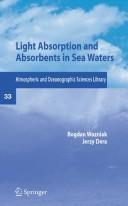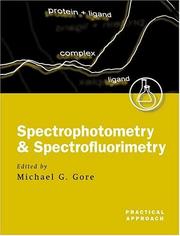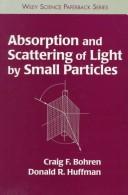| Listing 1 - 10 of 24 | << page >> |
Sort by
|
Book
ISBN: 3030876837 3030876829 Year: 2021 Publisher: Cham, Switzerland : Springer,
Abstract | Keywords | Export | Availability | Bookmark
 Loading...
Loading...Choose an application
- Reference Manager
- EndNote
- RefWorks (Direct export to RefWorks)
The book aims to the description of recent progress in studies of light absorption and scattering in turbid media. In particular, light scattering/oceanic optics/snow optics research community will greatly benefit from the publication of this book.
Light absorption. --- Absorption of light --- Light --- Optical absorption --- Absorption --- Opacity (Optics)
Book
ISBN: 1000035591 3731500566 Year: 2013 Publisher: KIT Scientific Publishing
Abstract | Keywords | Export | Availability | Bookmark
 Loading...
Loading...Choose an application
- Reference Manager
- EndNote
- RefWorks (Direct export to RefWorks)
In this book, the first high-speed silicon-organic hybrid (SOH) modulator is demonstrated by exploiting a highly-nonlinear polymer cladding and a silicon waveguide. By using a liquid crystal cladding instead, an ultra-low power phase shifter is obtained. A third type of device is proposed for achieving three-wave mixing on the silicon-organic hybrid (SOH) platform. Finally, new physical constants which describe the optical absorption in charge accumulation/inversion layers in silicon are determined.
optical absorption --- high-speed modulators --- mid-IR --- Silicon photonics --- liquid crystals

ISBN: 1280865350 9786610865352 0387495606 Year: 2007 Volume: 33 Publisher: New York ; London : Springer,
Abstract | Keywords | Export | Availability | Bookmark
 Loading...
Loading...Choose an application
- Reference Manager
- EndNote
- RefWorks (Direct export to RefWorks)
This book takes a fresh, holistic approach to the problems of light absorption and absorbers in seawaters, discussing the fundamentals of light absorption at various depths in seawaters of different trophicity by absorbers of diverse origin. The authors have drawn their information from a substantial body of contemporary research results published in the subject literature (over 700 references) as well as their own work during the last 30 years. No other book presently available examines the issues of light absorption and absorbers in seawaters in such a manner. The book is intended primarily for students, engineers and scientists professionally involved with the marine environment; nevertheless, the authors hope that it will also find favor among all who take an interest in the nature of our Earth, especially the seas and oceans. The components most strongly differentiating the various types of sea/ocean waters from the optical point of view – the water itself, the organic and inorganic substances dissolved in it, and the manifold particles suspended in it – receive comprehensive treatment. The spectral absorption of light by pure water in its various states of matter and by atoms and ions of sea salt is also given ample coverage. The interaction of light with various kinds of organic molecules is analyzed in detail, as are the light absorption spectra of the principal groups of these substances present in the sea in dissolved form. The physical and chemical properties, as well as the optical constants, of organic and inorganic suspended particulate matter (SPM), are discussed in the context of their relationship to the light absorption properties of SPM. Special emphasis is placed on the role of the phytoplankton and the pigments it contains which are particularly strong and important absorbers of visible light in the sea. The authors are professors of physics with practical experience in the field of marine research going back 35 (BW) and 45 (JD) years. They are also the authors of a large number of research papers and several books, e.g., J. Dera, Marine Physics (Elsevier (The Netherlands) and PWN (Poland)), W. Smekot-Wensierski, B. Wozniak et al. Absorptionseigenschaften des marinen Phytoplanktons [Absorption properties of marine phytoplankton] (GKSS-Forschungszentrum Geesthacht GmbH, Germany).
Seawater --- Light absorption. --- Underwater light. --- Optical properties. --- Submarine light --- Underwater illumination --- Light --- Absorption of light --- Optical absorption --- Absorption --- Opacity (Optics) --- Optical oceanography

ISBN: 0199638128 0199638136 Year: 2000 Publisher: Oxford [etc.] : Oxford University Press,
Abstract | Keywords | Export | Availability | Bookmark
 Loading...
Loading...Choose an application
- Reference Manager
- EndNote
- RefWorks (Direct export to RefWorks)
Analytical chemistry --- spectrofotometrie --- Biochemistry --- Fluorimetry --- Spectrophotometry --- 535.243 --- Fluorescence analysis --- Fluorimetric analysis --- Fluorometric analysis --- Fluorometry --- Luminescence analysis --- Technique --- Astronomical photometry --- SPECTROPHOTOMETRY --- FLUOROMETRY --- OPTICAL ABSORPTION --- FLUORESCENCE --- PHOSPHORESCENCE --- CIRCULAR DICHROISM --- PROTEINS --- DNA --- PROPERTIES

ISBN: 047105772X 9780471057727 Year: 1983 Publisher: New York (N.Y.): Wiley,
Abstract | Keywords | Export | Availability | Bookmark
 Loading...
Loading...Choose an application
- Reference Manager
- EndNote
- RefWorks (Direct export to RefWorks)
Aerosols --- Light absorption --- Light --- Optical properties --- Scattering --- -Light --- -Light absorption --- Absorption of light --- Optical absorption --- Absorption --- Opacity (Optics) --- Electromagnetic waves --- Light sources --- Spectrum analysis --- Colloids --- Gases --- Light absorption. --- Optical properties. --- Scattering. --- Light scattering --- Scattering of light --- Diffusion --- Particles --- Reflection (Optics) --- Refraction --- Scattering (Physics) --- Aerosols - Optical properties --- Light - Scattering
Book
ISBN: 146148796X 1461487978 Year: 2014 Publisher: New York, NY : Springer New York : Imprint: Springer,
Abstract | Keywords | Export | Availability | Bookmark
 Loading...
Loading...Choose an application
- Reference Manager
- EndNote
- RefWorks (Direct export to RefWorks)
The interaction of radiation with matter is a fundamental process in the universe; in particular, the absorption and scattering of radiation by matter (the opacity) govern the formation, evolution, and structure of stars and planets. But opacity is also important in many terrestrial applications in which radiation is the dominant means of energy transfer, such as controlled nuclear-fusion, laser ablation, atmospheric entry and reentry, and the "greenhouse" effect. This book covers all aspects of opacity and equations of state for plasmas, gases, vapors, and dust and emphasizes the continuous transformation of phases and molecular compositions with changing density and temperature under conditions of local thermodynamic equilibrium (LTE) while preserving the basic abundances of the chemical elements in a mixture.
Opacity. --- Opacity (Optics) --- Light absorption --- Physics --- Physical Sciences & Mathematics --- Light & Optics --- Light absorption. --- Absorptivity (Optics) --- Density, Optical --- Optical density --- Absorption of light --- Light --- Optical absorption --- Absorption --- Physics. --- Observations, Astronomical. --- Astronomy --- Astronomy, Observations and Techniques. --- Observations. --- Optics --- Astronomical observations --- Observations, Astronomical --- Natural philosophy --- Philosophy, Natural --- Physical sciences --- Dynamics --- Astronomy—Observations.
Book
Year: 2021 Publisher: Basel, Switzerland MDPI - Multidisciplinary Digital Publishing Institute
Abstract | Keywords | Export | Availability | Bookmark
 Loading...
Loading...Choose an application
- Reference Manager
- EndNote
- RefWorks (Direct export to RefWorks)
Recent research and development in the field of high-current circuit breaker technology are devoted to meeting two challenges: the environmental compatibility and new demands on electrical grids caused by the increasing use of renewable energies. Electric arcs in gases or a vacuum are the key component in the technology at present and will play a key role also in future concepts, e.g., for hybrid and fast switching required for high-voltage direct-current (HVDC) transmission systems. In addition, the replacement of the environmentally harmful SF6 in gas breakers and gas-insulated switchgear is an actual issue. This Special Issue comprises eight peer-reviewed papers, which address recent studies of switching arcs and electrical insulation at high and medium voltage. Three papers consider issues of the replacement of the environmentally harmful SF6 by CO2 in high-voltage gas circuit breakers. One paper deals with fast switching in air with relevance for hybrid fault current limiters and hybrid HVDC interrupters. The other four papers illustrate actual research on vacuum current breakers as an additional option for environmentally compatible switchgear; fundamental studies of the vacuum arc ignition, as well as concepts for the use of vacuum arcs for DC interruption.
Technology: general issues --- vacuum circuit breaker --- double break --- prestrike characteristics --- vacuum interrupter --- prestrike gap --- gaseous breakdown --- SF6 --- CO2 --- surface roughness --- statistical enlargement laws --- vacuum arc --- DC circuit breaker --- current interruption --- magnetic field --- plasma physics --- zero-crossing --- circuit breaker --- switching arc --- optical emission spectroscopy --- ablation --- current zero --- SF6 alternative gases --- PTFE --- optical absorption spectroscopy --- Swan bands --- CuF --- hybrid dc circuit breaker --- vacuum arc commutation --- solid-state switch --- vacuum arc voltage --- air arc plasma --- Thomson actuator --- magnetohydrodynamic simulations --- fast switch --- optical diagnostics --- vacuum circuit breaker --- double break --- prestrike characteristics --- vacuum interrupter --- prestrike gap --- gaseous breakdown --- SF6 --- CO2 --- surface roughness --- statistical enlargement laws --- vacuum arc --- DC circuit breaker --- current interruption --- magnetic field --- plasma physics --- zero-crossing --- circuit breaker --- switching arc --- optical emission spectroscopy --- ablation --- current zero --- SF6 alternative gases --- PTFE --- optical absorption spectroscopy --- Swan bands --- CuF --- hybrid dc circuit breaker --- vacuum arc commutation --- solid-state switch --- vacuum arc voltage --- air arc plasma --- Thomson actuator --- magnetohydrodynamic simulations --- fast switch --- optical diagnostics
Book
Year: 2021 Publisher: Basel, Switzerland MDPI - Multidisciplinary Digital Publishing Institute
Abstract | Keywords | Export | Availability | Bookmark
 Loading...
Loading...Choose an application
- Reference Manager
- EndNote
- RefWorks (Direct export to RefWorks)
Recent research and development in the field of high-current circuit breaker technology are devoted to meeting two challenges: the environmental compatibility and new demands on electrical grids caused by the increasing use of renewable energies. Electric arcs in gases or a vacuum are the key component in the technology at present and will play a key role also in future concepts, e.g., for hybrid and fast switching required for high-voltage direct-current (HVDC) transmission systems. In addition, the replacement of the environmentally harmful SF6 in gas breakers and gas-insulated switchgear is an actual issue. This Special Issue comprises eight peer-reviewed papers, which address recent studies of switching arcs and electrical insulation at high and medium voltage. Three papers consider issues of the replacement of the environmentally harmful SF6 by CO2 in high-voltage gas circuit breakers. One paper deals with fast switching in air with relevance for hybrid fault current limiters and hybrid HVDC interrupters. The other four papers illustrate actual research on vacuum current breakers as an additional option for environmentally compatible switchgear; fundamental studies of the vacuum arc ignition, as well as concepts for the use of vacuum arcs for DC interruption.
Technology: general issues --- vacuum circuit breaker --- double break --- prestrike characteristics --- vacuum interrupter --- prestrike gap --- gaseous breakdown --- SF6 --- CO2 --- surface roughness --- statistical enlargement laws --- vacuum arc --- DC circuit breaker --- current interruption --- magnetic field --- plasma physics --- zero-crossing --- circuit breaker --- switching arc --- optical emission spectroscopy --- ablation --- current zero --- SF6 alternative gases --- PTFE --- optical absorption spectroscopy --- Swan bands --- CuF --- hybrid dc circuit breaker --- vacuum arc commutation --- solid-state switch --- vacuum arc voltage --- air arc plasma --- Thomson actuator --- magnetohydrodynamic simulations --- fast switch --- optical diagnostics
Book
Year: 2021 Publisher: Basel, Switzerland MDPI - Multidisciplinary Digital Publishing Institute
Abstract | Keywords | Export | Availability | Bookmark
 Loading...
Loading...Choose an application
- Reference Manager
- EndNote
- RefWorks (Direct export to RefWorks)
Recent research and development in the field of high-current circuit breaker technology are devoted to meeting two challenges: the environmental compatibility and new demands on electrical grids caused by the increasing use of renewable energies. Electric arcs in gases or a vacuum are the key component in the technology at present and will play a key role also in future concepts, e.g., for hybrid and fast switching required for high-voltage direct-current (HVDC) transmission systems. In addition, the replacement of the environmentally harmful SF6 in gas breakers and gas-insulated switchgear is an actual issue. This Special Issue comprises eight peer-reviewed papers, which address recent studies of switching arcs and electrical insulation at high and medium voltage. Three papers consider issues of the replacement of the environmentally harmful SF6 by CO2 in high-voltage gas circuit breakers. One paper deals with fast switching in air with relevance for hybrid fault current limiters and hybrid HVDC interrupters. The other four papers illustrate actual research on vacuum current breakers as an additional option for environmentally compatible switchgear; fundamental studies of the vacuum arc ignition, as well as concepts for the use of vacuum arcs for DC interruption.
vacuum circuit breaker --- double break --- prestrike characteristics --- vacuum interrupter --- prestrike gap --- gaseous breakdown --- SF6 --- CO2 --- surface roughness --- statistical enlargement laws --- vacuum arc --- DC circuit breaker --- current interruption --- magnetic field --- plasma physics --- zero-crossing --- circuit breaker --- switching arc --- optical emission spectroscopy --- ablation --- current zero --- SF6 alternative gases --- PTFE --- optical absorption spectroscopy --- Swan bands --- CuF --- hybrid dc circuit breaker --- vacuum arc commutation --- solid-state switch --- vacuum arc voltage --- air arc plasma --- Thomson actuator --- magnetohydrodynamic simulations --- fast switch --- optical diagnostics
Book
ISBN: 3038976954 3038976946 Year: 2019 Publisher: MDPI - Multidisciplinary Digital Publishing Institute
Abstract | Keywords | Export | Availability | Bookmark
 Loading...
Loading...Choose an application
- Reference Manager
- EndNote
- RefWorks (Direct export to RefWorks)
Although the seminal work of Fujishima et al. dates back to 1971, TiO2 still remains the most diffused and studied semiconductor, employed in photo-oxidation processes for cleantech (i.e., polluted water and air treatment), in solar fuel production (mainly hydrogen production by water photo splitting), and in Carbon Capture and Utilization (CCU) processes by CO2 photoreduction. The eleven articles, among them three reviews, in this book cover recent results and research trends of various aspects of titanium dioxide photocatalysis, with the chief aim of improving the final efficiency of TiO2-based materials. Strategies include doping, metal co-catalyst deposition, and the realization of composites with plasmonic materials, other semiconductors, and graphene. Photocatalysts with high efficiency and selectivity can be also obtained by controlling the precise crystal shape (and homogeneous size) and the organization in superstructures from ultrathin films to hierarchical nanostructures. Finally, the theoretical modeling of TiO2 nanoparticles is discussed and highlighted. The range of topics addressed in this book will stimulate the reader’s interest as well as provide a valuable source of information for researchers in academia and industry.
UV-visible --- n/a --- oxidative reaction systems --- photodegradation --- nanospheres --- heterojunction --- Ag/AgCl@TiO2 fibers --- polymorphism --- XRD --- copper-modified titania --- ultrasonic vibration --- brookite --- TiO2 modification --- simulated Extended X-ray Adsorption Fine-Structure (EXAFS) --- nanorod spheres --- trapped electrons --- flame-spray pyrolysis --- titania/water interface --- microwave irradiation --- plasmonic photocatalyst --- graphene-TiO2 --- photocatalytic hydrogen production --- microstreaming --- B3LYP --- HRTEM --- hardness --- printing and dyeing wastewater --- SCC-DFTB --- TiO2 --- photoelectrochemistry --- titanium --- bulk defects --- methanol photo-steam reforming --- spray coating --- sol-gel --- FTIR --- S-doping --- photocatalysis --- sulfidation --- lattice defects --- polymorph --- anodization --- pine-cone TiO2 nanoclusters --- nanorod arrays --- formation mechanism --- Cu and Pt nanoparticles --- excitons --- TiO2 nanotubes --- adhesion --- trapping --- flexible substrates --- optical absorption --- large-sized films --- surface defects --- titanium dioxide --- accumulated electrons
| Listing 1 - 10 of 24 | << page >> |
Sort by
|

 Search
Search Feedback
Feedback About UniCat
About UniCat  Help
Help News
News